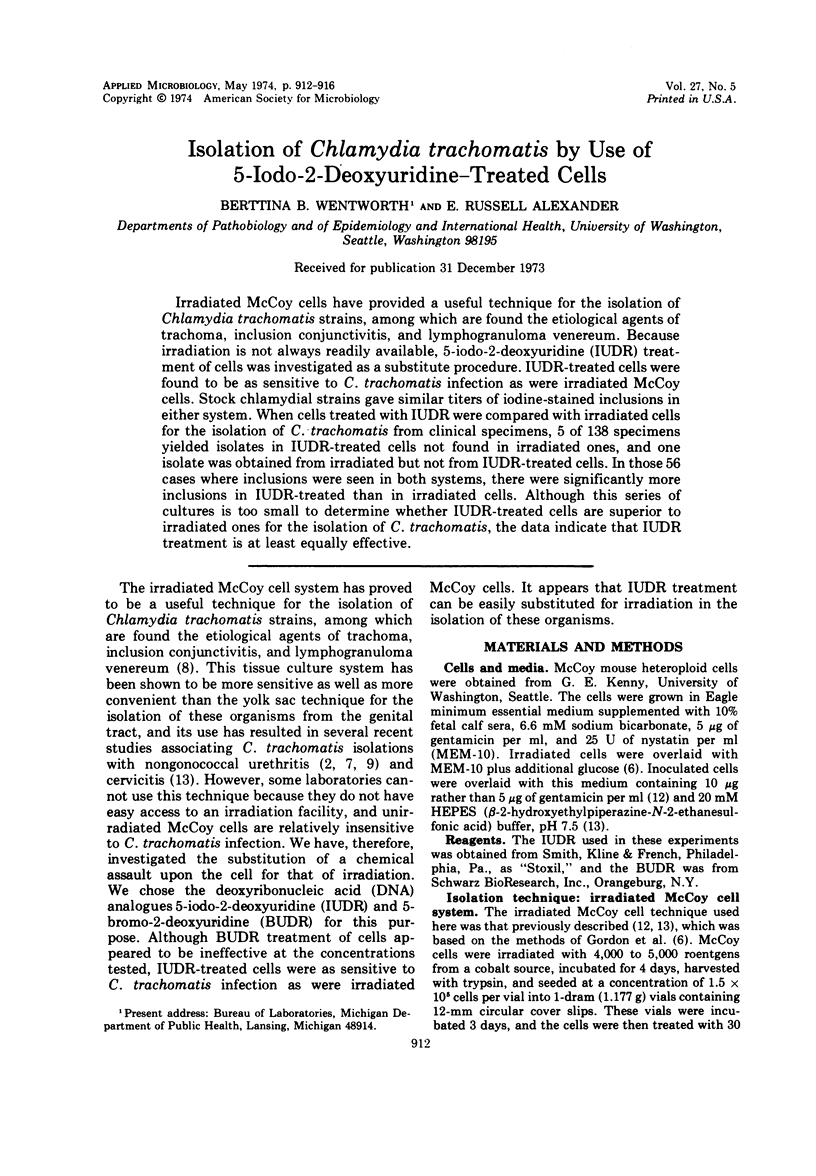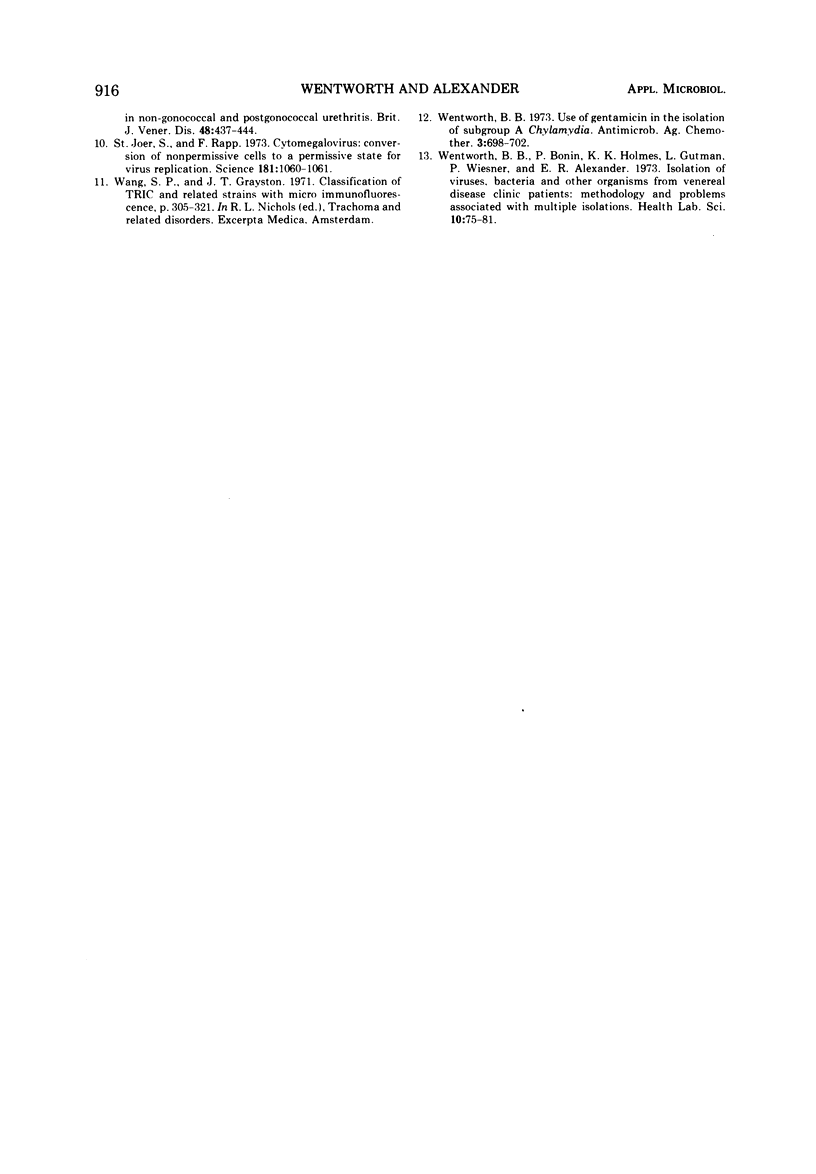Abstract
Irradiated McCoy cells have provided a useful technique for the isolation of Chlamydia trachomatis strains, among which are found the etiological agents of trachoma, inclusion conjunctivitis, and lymphogranuloma venereum. Because irradiation is not always readily available, 5-iodo-2-deoxyuridine (IUDR) treatment of cells was investigated as a substitute procedure. IUDR-treated cells were found to be as sensitive to C. trachomatis infection as were irradiated McCoy cells. Stock chlamydial strains gave similar titers of iodine-stained inclusions in either system. When cells treated with IUDR were compared with irradiated cells for the isolation of C. trachomatis from clinical specimens, 5 of 138 specimens yielded isolates in IUDR-treated cells not found in irradiated ones, and one isolate was obtained from irradiated but not from IUDR-treated cells. In those 56 cases where inclusions were seen in both systems, there were significantly more inclusions in IUDR-treated than in irradiated cells. Although this series of cultures is too small to determine whether IUDR-treated cells are superior to irradiated ones for the isolation of C. trachomatis, the data indicate that IUDR treatment is at least equally effective.
Full text
PDF




Selected References
These references are in PubMed. This may not be the complete list of references from this article.
- Dunlop E. M., Vaughan-Jackson J. D., Darougar S., Jones B. R. Chlamydial infection. Incidence in 'non-specific' urethritis. Br J Vener Dis. 1972 Dec;48(6):425–428. doi: 10.1136/sti.48.6.425. [DOI] [PMC free article] [PubMed] [Google Scholar]
- Friis R. R. Interaction of L cells and Chlamydia psittaci: entry of the parasite and host responses to its development. J Bacteriol. 1972 May;110(2):706–721. doi: 10.1128/jb.110.2.706-721.1972. [DOI] [PMC free article] [PubMed] [Google Scholar]
- Gerber P. Activation of Epstein-Barr virus by 5-bromodeoxyuridine in "virus-free" human cells (complement-fixing antigen-immunofluorescence-leukocytes). Proc Natl Acad Sci U S A. 1972 Jan;69(1):83–85. doi: 10.1073/pnas.69.1.83. [DOI] [PMC free article] [PubMed] [Google Scholar]
- Gordon F. B., Dressler H. R., Quan A. L., McQuilkin W. T., Thomas J. I. Effect of ionizing irradiation on susceptibility of McCoy cell cultures to Chlamydia trachomatis. Appl Microbiol. 1972 Jan;23(1):123–129. doi: 10.1128/am.23.1.123-129.1972. [DOI] [PMC free article] [PubMed] [Google Scholar]
- Gordon F. B., Harper I. A., Quan A. L., Treharne J. D., Dwyer R. S., Garland J. A. Detection of Chlamydia (Bedsonia) in certain infections of man. I. Laboratory procedures: comparison of yolk sac and cell culture for detection and isolation. J Infect Dis. 1969 Oct;120(4):451–462. doi: 10.1093/infdis/120.4.451. [DOI] [PubMed] [Google Scholar]
- Oriel J. D., Reeve P., Powis P., Miller A., Nicol C. S. Chlamydial infection. Isolation of Chlamydia from patients with non-specific genital infection. Br J Vener Dis. 1972 Dec;48(6):429–436. doi: 10.1136/sti.48.6.429. [DOI] [PMC free article] [PubMed] [Google Scholar]
- St Jeor S., Rapp F. Cytomegalovirus: conversion of nonpermissive cells to a permissive state for virus replication. Science. 1973 Sep 14;181(4104):1060–1061. doi: 10.1126/science.181.4104.1060. [DOI] [PubMed] [Google Scholar]
- Wentworth B. B., Bonin P., Holmes K. K., Gutman L., Wiesner P., Alexander E. R. Isolation of viruses, bacteria and other organisms from venereal disease clinic patients: methodology and problems associated with multiple isolations. Health Lab Sci. 1973 Apr;10(2):75–81. [PubMed] [Google Scholar]
- Wentworth B. B. Use of gentamicin in the isolation of subgroup A Chlamydia. Antimicrob Agents Chemother. 1973 Jun;3(6):698–702. doi: 10.1128/aac.3.6.698. [DOI] [PMC free article] [PubMed] [Google Scholar]


